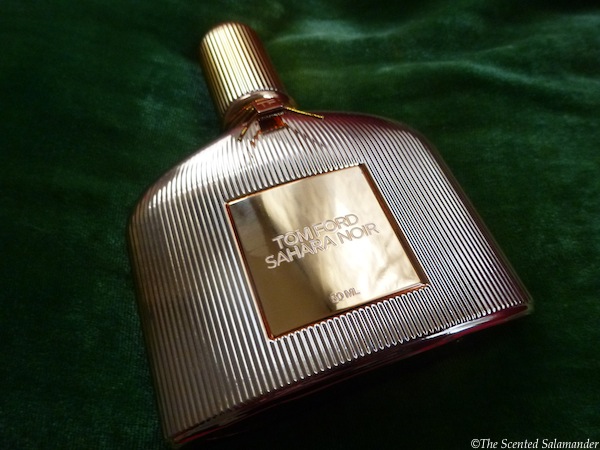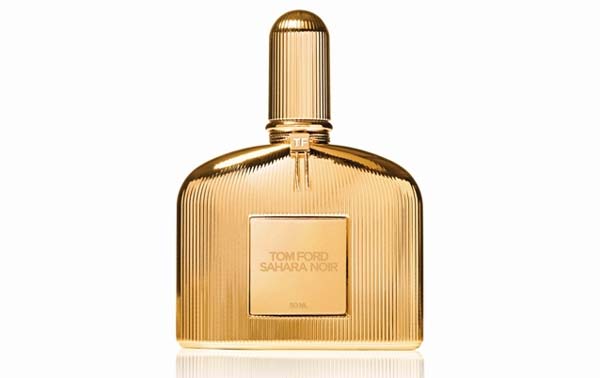Tom Ford Sahara Noir (2013): "Franc Encense", Purity & Atmospheric Character {Perfume Review & Musings}

The latest launch by Tom Ford, Sahara Noir, I will argue, takes us away from the catwalks of the fashion world and into the purer world of naturals and their potential direct effects on the human soul and psyche.
Presented as illustrative of Ford's affinities with the Middle East, Sahara Noir could have been anticipated by anyone knowing his previous work as a flaming, opulent Oriental composition. It surprisingly turns out to be a much simpler proposition than that. It is not therefore a new flourish on, say, the venomous, thick floral potion that is Black Orchid, only with more incense and dry heat blowing from the winds of the desert. The advertizing featuring model Lais Ribeiro is like a visual proposition separate it seems from the purpose and personality of the fragrance, there to suggest glamour, but strangely dissociated from it, a silent movie siren whose unuttered ciphers are the codes of luxury, fashion and old Hollywood glamour, which have been superimposed upon the perfume, itself in search of its antiquarian roots...
Sahara Noir opens on a powerful rush of cistus, the Orpur® grade, a quality-control label certified by Swiss fragrance company Givaudan for their natural ingredients for which they follow the guidelines of the United Nations Conference on Trade and Development. They describe these select ingredients as "a special collection of more than 50 pure naturals from Givaudan which are the best of the best of our natural portfolio," It feels indeed pristine an redolent with primal olfactory energy.
At the same time, the opening accord is ornate, Oriental, and precious thanks to the internal complexityfound within the ingredients more than in the juxtaposition of notes and accords meant to a great extent to mimic the complexity of nature in a modern-day, average fragrance balancing out synthetics and naturals. In this perfume, the simple complexity of nature has to some extent taken over. To showcase this phenomenon, the structure of the perfume is simple, linear, and very much in fact like a "solicense" to paraphrase the classical terminology of "soliflore", secondary notes blending in to support the main note of frankincense.
Subjectively, I start discovering through the rush of memories a chief, more abstract and natural quality ascribed to frankincense, reported over the centuries: its atmospheric quality. It personally and immediately evokes for me the typical woody scent of cedar boathouses in Srinagar, Kashmir - it is actually quite uncanny. It transports you back in time to a region, a time, a place of fragrant dwellings on water where floating houses make the air smell of fragrant, resinous cecar wood all around. A note of beeswax reinforces the sappy quality of the woodsy palette of notes displayed by the fragrance making them smell fresh, like freshly cut wood.You expected a lush Oriental but in reality you are struck by the ambient quality of Sahara Noir.

Used to make the "air sweet", to dispel negative energies after a row, even used to make the voice travel better through air - this based on scientific evidence that found that human voice carries better in air fumigated with frankincense - the association of frankincense with air and atmosphere is as long as its usage.
Setting aside the personal memories of travels to Kashmir, it evokes more mythically to my mind the carpenter's workshop in which Jesus toiled before he reached the middle of life. The fragrance feels biblical even more than Oriental. It feels as if you had entered a room where shavings of wood are strewn on the floor and where candles made of beeswax are lit. There is something Christmas-like about the perfume; and it is curiously comforting too.
The atmospheric character of Sahara Noir unfuls further translating next as the kind of incensey smokiness that gets tangled in the folds of traditional black Middle Eastern garb. Sahara Noir has "rémanence" as the French say radiating around the point where you sprayed it onto the skin. It seems bent on a sole effect, to diffuse the famed note of frankincense as best it can. It is like getting a frankincense fix.
In The Incense Bible by Kerry Hughes (2007), the author has a section on the famed note stressing the fact that it is actually a blend, not an ingredient. In the course of history up to 25 different types of Boswellia might have been used together with other ingredients to create the blend called "frankincense". Citing the research by A. O. Tucker, "Frankincense and Myrrh", Economic Botany 40 (4) (1986), she underlines the information that in the contemporary world, what we smell as frankincense is "derived mostly from B. Carteri, B. frereana, and B. Serrata," while "In ancient times, B. Papyrifera was thought to be mainly used for deriving frankincense." A Catholic blend for frankincense is repertoried in the research conducted by J. H. Langenheim, also quoted in the book ,"Plant Resins: Chemistry, Evolution, Ecology, Ethnobotany" (2004), and given as 66% frankincense, 27% benzoin and 7% storax.
Etymologically, the English word "frankincese" comes from 14th century old French "franc encense" from "franc" meaning "noble, true" designating the highest quality of incense. You can see how a circle forms with the Givaudan project today of offerring the "best of the best" of naturally sourced incense.
Why therefore corrupt the naturalness of this Orpur grade of frankincense? Apparently, the choice the perfumer made here was to let its energy and personality shine through supported discreetly only by a host of more minimal touches. While the advertizing slants the perfume towards the feminine, Sahara Noir reiterates the sometimes forgotten truth that perfumery materials are asexual, smelling neither of the feminine nor the masculine, and like angels, travel through the air unemcumbered by such mundane, human considerations.
Fragrance notes: frankincense, cistus essence graded Orpur®, bitter orange, Jordanian oasis calamus, Levantine cypress / frankincense essence Orpur® , cinnamon, cool papyrus extract, Egyptian jasmine templar and rose absolute from Morocco, beeswax extraction from Burma, labdanum (labdanum absolute & fractioned ambreinol), benzoin, vanilla, cedar, frankincense resin, agarwood and balsam.
For more information about the fragrance, you can read the news announcement









